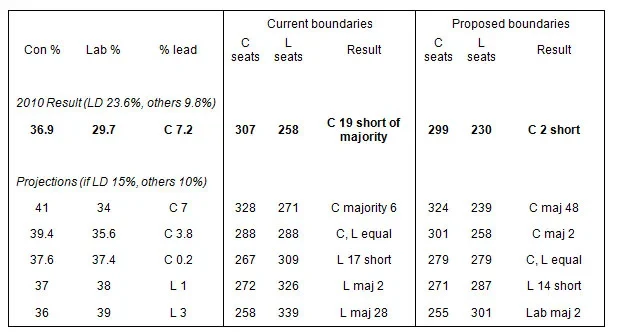How Clegg could cost Tories 800 votes per seat: YouGov President Peter Kellner projects how reform could pan out
Nick Clegg has raised the stakes. Nobody can be quite sure how the politics of constitutional (non-)reform will play out. But by vowing to block the plan to reduce the number of MPs from 650 to 600, the Lib Dem leader has changed the prospects for the next General Election.
Want to receive Peter Kellner's commentaries by email? Subscribe here
Let’s do the maths (or, as Americans say, the math). There are many permutations, but the table below shows the key points. First, it shows how many seats Labour and the Tories won last time – and how many they would have won had the proposed boundaries been in force. Then it considers how votes might translate into seats next time under five different scenarios.

The first point to note is the winning post. To win an overall majority when there are 650 MPs, a party needs 326 seats. When there are just 600 MPs the winning post is 301 seats.
Two years ago, the Tories fell 19 seats short: that is why they needed, and still need, the Lib Dems. But has the proposed boundaries been in force, David Cameron would have been just two seats short. He could have governed alone, on the grounds that the opposition parties would never all join forces to defeat him. (For one thing, Sinn Fein’s five MPs never take part in House of Commons proceedings.)
Now to the next election and my five scenarios.
I have based my calculations on the detailed analysis of my YouGov colleague Anthony Wells. These calculations are based in turn on the provisional work of the Boundary Commissions. The commissions have been busy revising their initial proposals, so, if they do go ahead, some of the detailed numbers would change. But they would not affect the big picture.
As always with such projections, some simplifying assumptions must be made. The biggest, and on the face of it most ludicrous, is that the swing in every seat throughout Britain is identical. In practice, of course, swings vary; however, the variations tend to cancel each other out. Barchester North might swing more than the average, while Grimtown Central swings less. These variations make it hard to predict every individual seat, but do not undermine the projection of the aggregate number of seats likely to be won by each party.
What CAN make a difference are systematic variations. Suppose the swing in Conservative-Labour marginal differs from the national average; or if Lib Dem MPs manage to mobile a personal following that help them to resist the national unpopularity of their party. These things would make a difference, but probably not a LARGE difference.
One final throat-clearing point. In order to avoid having to devise a vast, bamboozling, four-dimensional chart, I assume that the Lib Dems end up with 15% of the national vote share (more than in recent YouGov MPs, but still well down on their 2010 vote share), and minor parties 10%, much the same as two years ago.
This means that, in my scenarios, Labour and the Tories win 75% between them. It’s perfectly possible to produce projections on other assumptions; but you’d have to vary the overall Labour-plus-Tory total a lot to arrive at markedly different conclusions. (Anyone wishing to try out their own scenarios should go to these pages on Anthony’s UK Polling Report website: The Swing Calculator and the Swingometer's 2011 Provisional Boundaries.
What, then do these scenarios tell us?
- For the Conservatives to win an overall majority under the current boundaries, they need a seven point lead in the popular vote. (This is the lead they obtained two years ago, when they fell short. But, the way things are looking, they would win the extra seats they need from the Lib Dems, without needing to gain any more from Labour.) However, under the proposed boundaries, they would need to lead Labour by just 3.8%.
This makes Clegg’s decision to block reform seriously bad news for the Tories. If they have to fight the next election on the existing boundaries, they suffer a penalty equivalent to a 1.6% swing. This means that they need to push their vote up by an extra 800 votes per seat, and push Labour’s down by 800, compared with what they would need on the proposed boundaries, in order to achieve an overall majority in the next parliament. As any candidate knows, the last few hundred votes are often the hardest, and most vital, to win over. - Without the change, a 3.8% lead would leave the Tories not with an outright victory, but exactly the same number of seats as Labour. This is a measure of how, for various reasons, the current boundaries penalise the Conservatives. Without reform, Labour could win one million fewer votes than the Tories across Britain, and still end up with more MPs.
- On the present boundaries, Labour would need a lead in the popular vote of just one percentage point to win an overall majority. But under the proposed boundaries, they would need a three-point lead.
By vowing to block the boundary changes, Nick Clegg has just made Ed Miliband’s task significantly easier.
See all of our political results here
See all of our political trackers on political issues here
Want to receive Peter Kellner's commentaries by email? Subscribe here









